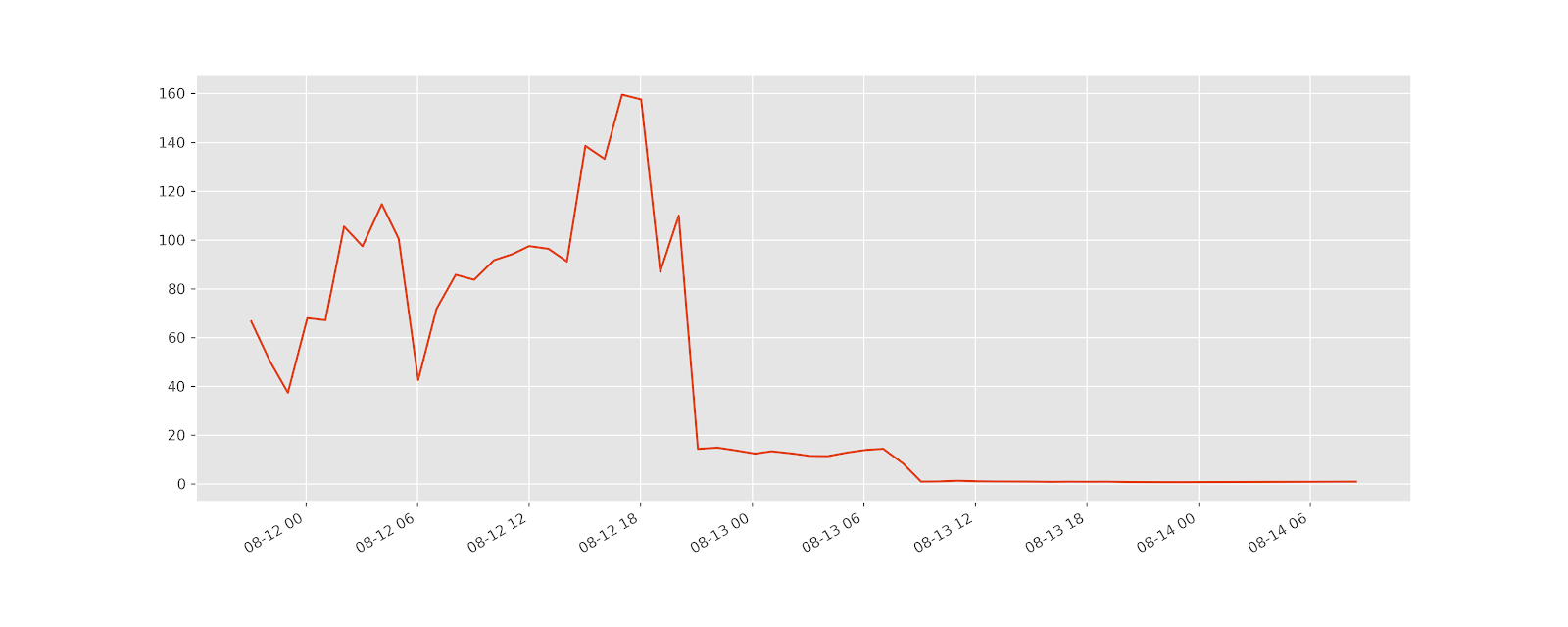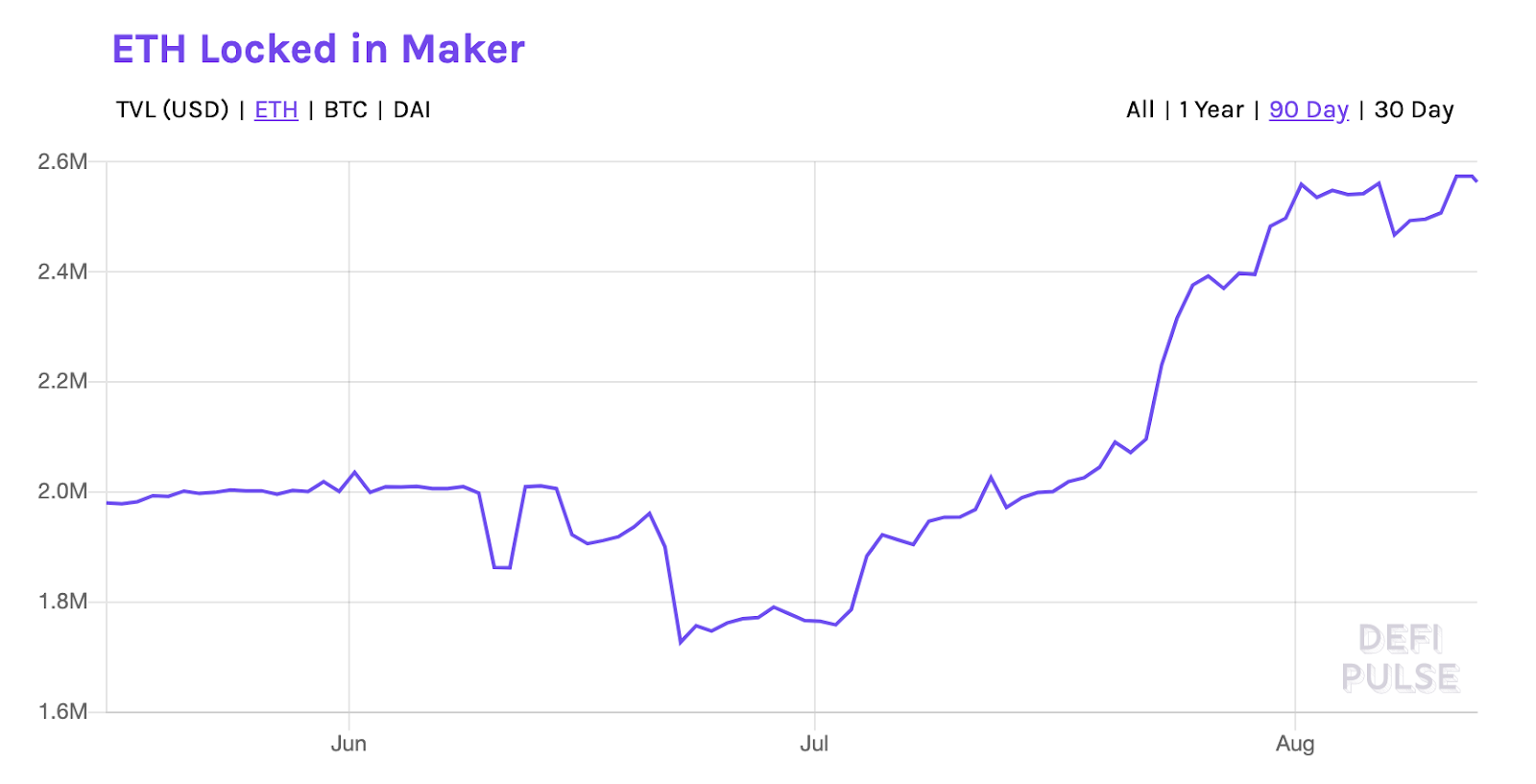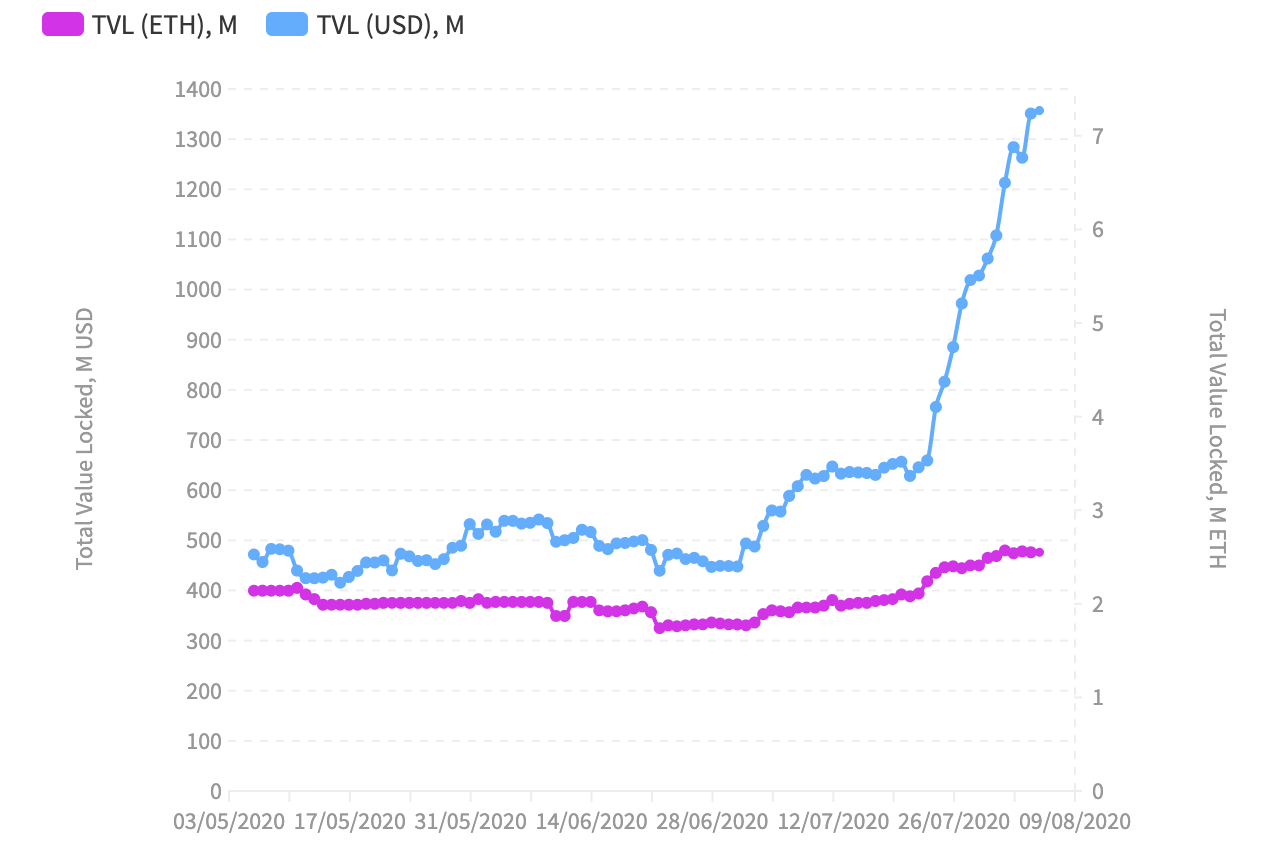Party Like It's 2017: Whales and Degenerates of DeFi
DeFi is expanding at an impressive rate, attracting the market's attention with absurd yields. Yet, the niche is still dominated by whales and degenerate speculators.

Key Takeaways
- While DeFi has sound long term prospects, it's currently driven by speculation
- The number of DeFi users is quickly growing, but it's still tiny and composed mostly of whales and risk-taking speculators
- Roadblocks like Ethereum's limited transactions per second obstruct DeFi's mass adoption
Share this article
The DeFi craze is full-steam ahead: the total value locked has already passed $5 billion, the number of transactions on Ethereum hit 2018 levels, and gas prices are through the roof. Each passing day DeFi is looking more like a bubble.
We discussed the real practical use cases of DeFi with Federico Nitidi, creator of the liquidity pool tracker Uniswap ROI. His insights are valuable for estimating the actual structure of the market and its long-term potential, as well as the short-term risks.
Lending, borrowing, liquidity provision, arbitrage, and fundraising can potentially help the blockchain space disrupt the traditional economy, and big players in the space acknowledge such potential. However, a closer look at them shows that the niche is still dominated by whales and risk-taking speculators, affectionately known as “degens.”
Here’s a summary of the types of activities they do to churn a profit and why this tends to attract degenerates.
DeFi Lending
Lending on DeFi is a proxy to fixed income. Users can lend ETH on platforms like Compound or Aave, and make their capital available for others to borrow for interest.
The annual percentage yields (APYs) on DeFi platforms are lucrative compared to the traditional high-yield savings accounts. For instance, the APY for DAI stablecoin on Compound exceeds 3%, while the highest APY offered by the U.S. banks is 1.05%.
In addition to attractive yields, platforms like Compound incentivize users via the daily distribution of COMP governance tokens. The inclusion of COMP reward increases the APY to almost 6% in some cases.
Importantly, lending rates in DeFi come from the demand of margin traders and arbitrageurs. Borrowing requires locking up 150% of a loan’s size, so it doesn’t make much sense to borrow for anything besides short-term speculation.
Earning governance tokens by locking up assets is called liquidity mining, or yield farming. While the fundamental value of such tokens is questionable, speculation caused their prices to surge. Consequently, more users switched to liquidity mining to maximize profits. For instance, the Basic Attention Token (BAT) market on Compound was used extensively by liquidity miners, which led to a surge in BAT’s APY.
Decentralization enables the most extreme forms of liquidity mining. Since anyone is free to deploy a smart-contract on Ethereum, grass-roots projects with governance tokens started to appear. Such projects present an extremely high risk because professional teams don’t create them. Yet, it doesn’t prevent so-called “degens” from pouring millions of dollars into these smart-contracts.
A prime example of degen yield farming is the unaudited YAM project, which managed to attract hundreds of millions of dollars to unaudited smart-contracts in under a day. Shortly after, a governance bug made the protocol unworkable, and YAM tanked; perhaps the project really should have invested in an audit. The token’s price at one point exceeded $150, but now it trades under $1. This volatility is a clear indicator that the market is frothy.

Liquidity provision
Before DeFi, tokens with smaller market caps have been struggling with insufficient liquidity and high price slippages. Liquidity mining helped improve the situation, but there is another incentive in the form of trading fees on decentralized exchanges (DEXes).
The most liquid decentralized exchange at the moment of writing is Uniswap. It employs an Automated Market Making (AMM) function to orchestrate the liquidity; there’s no need for an order book, which creates a mostly passive investment opportunity. Users lock their assets in pools and earn trading fees.
While the AMM mostly automates liquidity management, each pool’s return varies depending on several factors. Hence, maneuvering between them is the best-earning strategy. For this purpose, liquidity providers can use tools like Uniswap ROI to monitor their investment in real-time and adapt their strategy.
Borrowing on DeFi
DeFi protocols are merely smart-contracts, so they can’t know who uses them. Hence, the platforms only allow overcollateralized loans to guarantee credit during price fluctuation.
The most developed lending platform in the space is Compound. It allows users to lock up collateral like ETH and borrow assets against it. The maximum amount that a user can get depends on the collateral factor; for ETH, it’s 0.75 (max 75 DAI loan per $100 of ETH).
The notion of overcollateralization narrows the range of potential use cases for borrowers. It doesn’t make much sense to lock-up 1,000 ETH and borrow 75% of its value if you want to start a business or buy a car. Borrowing on DeFi is currently only suitable for short-term speculation like leveraged trading.
It is important to note that some players in the blockchain space strive to extend the current boundaries of borrowing on the blockchain to more real-world applications, such as business credits or consumer loans. However, it remains a territory of exploration and is unlikely to see meaningful advancement in the current market cycle.
Despite the incentives, DeFi still has limited liquidity. Combined with high transaction fees, this creates an unfriendly environment for onboarding institutional and retail users. Liquidity across the niche is still not high enough for institutional activity. Moreover, expensive transactions on Ethereum make DeFi inaccessible for most retail players with smaller crypto holdings.
The small size of the DeFi community manifests itself in the data. The increasing number of active users doesn’t corroborate the high volume of transactions on Ethereum.

Federico Nitidi noted that while the DeFi space’s growth is impressive percentage-wise, the absolute number of users is still tiny compared to the extended crypto market. It’s exciting to see expansion, but the large-scale adoption of DeFi hasn’t started yet.
Currently, DeFi is most accommodating for hardened crypto veterans who already have significant holdings and are well aware of the niche’s complexity. They are taking advantage of new opportunities by employing short-term strategies like leveraged trading and flash loans.
Leveraged Trading
By combining lending and borrowing, traders can create leveraged positions on DeFi. Leverage increases the upside potential, but it also brings more risk.
Imagine Alice anticipates that ETH will go from $400 to $500 next week. She already has 1 ETH but wants to make extra profit. For this purpose, she can build leverage using Maker, Compound, or Aave.
Alice locks up 1 ETH on Maker and gets 264 DAI (66% of $400). She then goes to Uniswap, swaps DAI to ETH, adds more ETH to the collateral, and repeats the cycle several times. Eventually, she can build up to 3x leverage with $1,200 in the collateral and 800 DAI in debt.
If the market would go in her favor, and ETH goes to $500, the collateral value would increase to $1500, but her debt would remain at 800 DAI. After paying back DAI and interest, she would have around $700 to pocket, which means a $300 gain considering the initial investment of $400.
But if ETH would drop to $300, Alice would have a higher risk of being liquidated. The value of the ETH in the collateral would decline to $900, below the 150% collateralization ratio. Returning the collateral value to $1,200 would require $300 instead of $100 for an unleveraged loan.
Although the example above is exaggerated and the collateralization ratio of 150% isn’t safe in the first place, it illustrates how things can go wrong. Leverage should be approached with extra caution, because even if ETH appreciates in the long term, its fluctuations in the short term may lead to complete loss of funds due to liquidation.
Leverage and speculation within and outside of DeFi manifest themselves in the inflated total value locked (TVL), the metric often referenced to show how large DeFi has grown. Although the number of ETH locked on the platforms grow, the USD valuations increase much faster, distorting DeFi’s size perception.


Arbitrage with Flash Loans
The concept of arbitrage is simple: buy something where it’s cheap and sell it where it’s expensive. It’s used in every traditional market, including stocks and commodities. DeFi adds an entirely new layer to arbitrage: flash loans.
Flash loans emerged from the programmability of Ethereum. Since DeFi platforms are smart-contracts, interactions between them can be automated via complex transactions. The primary benefit of flash loans is that they eliminate the counterparty risk of holding assets.
Imagine Bob noticed that ETH on Huobi costs $390, while its price on Binance is $400. Theoretically, he can buy ETH on Huobi, withdraw it to Binance, and pocket the difference. However, if the price on Binance drops in the meantime, Bob loses his opportunity and becomes an ETH holder without a place to close the trade at a profit.
An automated DeFi transaction saves Bob from being left with ETH on his hands. If he sees a price discrepancy between DeFi platforms, he can create a complex transaction and use Aave to initiate a flash loan and fund arbitrage. If the prices change during the transaction execution, the transaction will fail, and Bob will only lose money on transaction fees.
Considering the high costs of gas on Ethereum, arbitrage isn’t profitable for everyone. To justify the potential losses the transactions have to be sizable. Otherwise, a few unsuccessful arbitrage attempts can destroy a small portfolio.
…And a New Kind of ICO
On top of all of the speculation, DeFi becomes a proving ground for reviving the ICO concept, which caused the 2017 bull-run. The new type of crowdfunding is called initial dex offering (IDO).
The vast majority of ICOs failed because of the lack of listings, which made it hard for investors to access or unload their tokens. Initial exchange offerings (IEOs) helped fix the problem, as the exchanges listed the projects they promoted.
IDOs improve on the ICO model by keeping fundraising on-chain and providing instant liquidity. Meanwhile, the decentralized nature of IDOs makes them more transparent than IEOs.
On the other hand, decentralization reopens the door for low-quality projects and scams. IEOs imply that exchanges do the due diligence for users and check for red flags, while ICOs and IDOs don’t. Hence, IDOs should be approached with extra caution.
Just a Bubble?
DeFi has a long way to go before it gets adopted at scale. Things like Ethereum’s scalability need to be improved, and new instruments like credit scores need to be implemented.
Still, the platforms have practical use cases and hold immense potential to help people better manage their finances. For now, things look like a bubble, but in the long-run, DeFi can deliver real value. With the speed of the niche’s development, it may not be too long before crypto diehards give way to retail and institutions.
